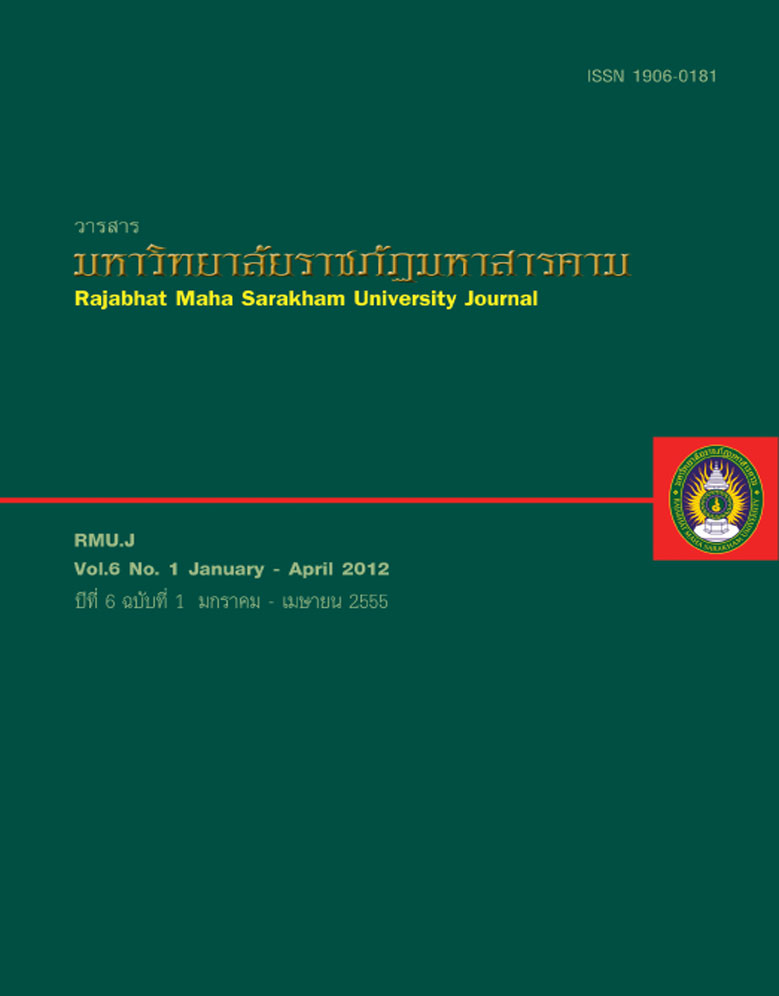Language Learning Strategies of EFL Business Students : A Case Study of Thai Business Students
Main Article Content
บทคัดย่อ
งานวิจัยนี้มีวัตถุประสงค์เพื่อศึกษาการใช้กลวิธีการเรียนภาษาในบริบทที่แตกต่างกัน คือ ในห้องเรียนและนอกห้องเรียนของนิสิตชาวไทยที่เรียนทางด้านธุรกิจในระดับอุดมศึกษาในประเทศไทย โดยแบ่งตามการใช้กลวิธีการเรียนภาษาของนิสิตในด้านธุรกิจที่มีสาขาวิชาเอกที่แตกต่างกันและความสามารถทางภาษาที่แตกต่างกัน กลุ่มตัวอย่างคือนิสิตชั้นปีที่ 2 มี จำนวน 187 คน โดยแบ่งออกเป็นสาขาการบัญชีจำนวน 68 คน สาขาการตลาดจำนวน 50 คนและสาขาการจัดการจำนวน 79 คน เครื่องมือที่ใช้ในการเก็บข้อมูล
คือแบบสอบถามการใช้กลวิธีการเรียนภาษามีค่าความเชื่อมั่นที่ 0.91 ซึ่งผู้วิจัย ได้พัฒนามาจาก Oxford’s Strategy Inventory forLanguage Learning (SILL) version 7.0 ข้อมูลที่ได้จะถูกนำมาวิเคราะห์โดยใช้ สถิติอันได้แก่ ส่วนเบี่ยงเบนมาตรฐาน เปอร์เซ็นต์pos-hoc และ MANOVA ทั้งนี้ผลการวิจัยพบว่า นิสิตที่ มีความสามารถทางภาษาสูงและนิสิตที่มีความสามารถทางภาษาตํ่าใช้กลวิธีการเรียนภาษาโดยรวมแตกต่างกันอย่างไม่มีนัยสำคัญที่ระดับ .05 และเมื่อพิจารณาในด้านสาขาวิชาเอกนั้นพบว่า นิสิตสาขาการบัญชีและการตลาดมีการใช้กลวิธีการเรียนภาษาที่คล้ายคลึงกันในขณะที่นิสิตสาขาการจัดการจะมีการใช้ที่แตกต่างไปบ้างเล็กน้อย นิสิตทั้ง3 สาขาในด้านธุรกิจมีแนวโน้มในการใช้กลวิธีการเรียนภาษาคล้ายคลึงกัน นอกจากนั้นยังพบว่านิสิตไทยที่เรียนทางด้านธุรกิจจะใช้
กลวิธีในบริบทในห้องเรียนด้านอารมณ์และความรู้สึก (Affective) บ่อยที่สุด ใช้กลวิธีด้านการจำ (Memory) ในบริบทนอกห้องเรียนบ่อยที่สุดและกลวิธีที่ใช้น้อยที่สุดคือ กลวิธีด้านสังคม (Social);
This study was aimed at investigating language learning strategies used in different settings: in-class
and out-of-class, by Thai business students at a tertiary level in Thailand in relation to different majors in
the same business field and different proficiency levels. The subjects consisted of 187 second-year business
students including 68 Accounting students, 50 Marketing students and 79 Management students. The
questionnaire on language learning strategy , adapted from Oxford’s Strategy Inventory for Language Learning
(SILL) version 7.0, with the reliability of 0.91 was used to collect data. Statistics used to analyze the data
were standard deviation, percentage, pos-hoc and MANOVA. It was found that overall the language learning
strategies used by the high- and the low-proficiency-level students were different but not at a significance
level of .05. Regarding majors, the strategies used by the Accounting and Marketing students were likely to
resemble each other, but the Management students employed strategies in a slightly different way. In each
aspect of language learning strategy use, three majors in the business field seemed to rely on the same
language learning strategy. Evidently, among the strategies employed in the in-class setting, the Affective
strategy group was the most frequently used, whereas the Memory group was the most often used outside
the classrooms and Social strategies were the least often used.
Article Details
1. บทความที่ลงตีพิมพ์ทุกเรื่องได้รับการตรวจทางวิชาการโดยผู้ประเมินอิสระ ผู้ทรงคุณวุฒิ (Peer Review) สาขาที่เกี่ยวข้อง อย่างน้อย 3 ท่าน ในรูปแบบ Double blind review
2. ข้อคิดเห็นใด ๆ ของบทความที่ลงตีพิมพ์ในวารสารมหาวิทยาลัยราชภัฏมหาสารคาม นี้เป็นของผู้เขียน คณะผู้จัดทำวารสารไม่จำเป็นต้องเห็นด้วย
3. กองบรรณาธิการวารสารมหาวิทยาลัยราชภัฏมหาสารคาม ไม่สงวนสิทธิ์การคัดลอกแต่ให้อ้างอิงแสดงที่มา


